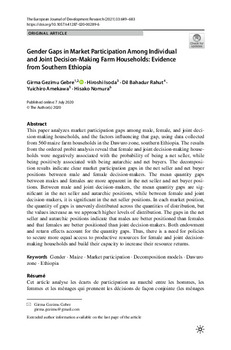Gender gaps in market participation among individual and joint decision-making farm households: evidence from Southern Ethiopia
Abstract
This paper analyzes market participation gaps among male, female, and joint decision-making households, and the factors influencing that gap, using data collected from 560 maize farm households in the Dawuro zone, southern Ethiopia. The results from the ordered probit analysis reveal that female and joint decision-making households were negatively associated with the probability of being a net seller, while being positively associated with being autarchic and net buyers. The decomposition results indicate clear market participation gaps in the net seller and net buyer positions between male and female decision-makers. The mean quantity gaps between males and females are more apparent in the net seller and net buyer positions. Between male and joint decision-makers, the mean quantity gaps are significant in the net seller and autarchic positions, while between female and joint decision-makers, it is significant in the net seller positions. In each market position, the quantity of gaps is unevenly distributed across the quantities of distribution, but the values increase as we approach higher levels of distribution. The gaps in the net seller and autarchic positions indicate that males are better positioned than females and that females are better positioned than joint decision-makers. Both endowment and return effects account for the quantity gaps. Thus, there is a need for policies to secure more equal access to productive resources for female and joint decision-making households and build their capacity to increase their resource returns.

